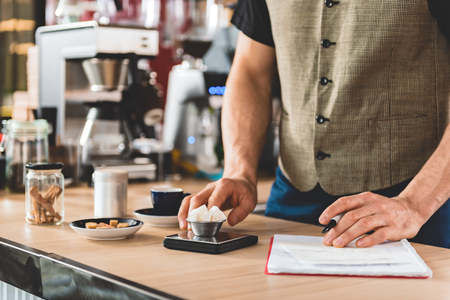Introduction to the U.S. Pour Over Coffee Scene
Welcome to a gentle journey into the heart of American coffee culture, where pour over brewing has blossomed into an art form cherished by both seasoned baristas and home enthusiasts. Across bustling city cafés and cozy suburban kitchens, pour over coffee has captured the attention of those seeking clarity, depth, and ritual in their daily cup. This method, celebrated for its hands-on approach and ability to highlight nuanced flavors, has become a symbol of intentional living and genuine connection. As we explore the distinctive pour over recipes crafted by leading U.S. coffee roasters, you’ll discover not only innovative techniques but also the personal philosophies that shape each brew. Prepare to experience the warmth and creativity that have made pour over a beloved staple across America’s diverse coffee landscape.
2. Selecting Beans: Spotlight on Top U.S. Roasters
When it comes to pour over coffee, the foundation of a great cup starts with exceptional beans. Across the United States, a vibrant community of specialty coffee roasters has risen to the challenge, each bringing their own signature style and regional flair. From the lush Pacific Northwest to the bustling cities of the East Coast, American roasters are celebrated for both their commitment to quality and their innovative approach to sourcing and roasting beans.
Renowned U.S. Coffee Roasters
The following table highlights a selection of leading American coffee roasters, their flagship beans, and the unique characteristics that define their approach:
| Roaster | Location | Signature Bean | Regional Influence |
|---|---|---|---|
| Stumptown Coffee Roasters | Portland, OR | Hair Bender Blend | Pioneering West Coast third wave movement; emphasizes direct trade and vibrant acidity. |
| Intelligentsia Coffee | Chicago, IL | Black Cat Classic Espresso | Midwestern precision; known for transparent sourcing and balanced profiles. |
| Blue Bottle Coffee | Oakland, CA | Three Africas Blend | West Coast minimalism; clean flavors, often with light roasts highlighting origin nuances. |
| Counter Culture Coffee | Durham, NC | Hologram Blend | Southeastern innovation; sustainability-focused with lively fruit notes. |
How Regional Preferences Shape Roasting Philosophy
The diversity in American coffee culture is reflected in how each region shapes its roasting philosophy. West Coast roasters often favor lighter roasts that celebrate bright acidity and delicate floral notes, inspired by the region’s progressive palate and access to fresh produce. In contrast, Midwest and East Coast roasters may lean toward medium or darker profiles—seeking balance, comfort, and rich chocolatey undertones suited to colder climates and traditional tastes.
This tapestry of regional preferences guides not just the roast profile but also sourcing relationships. Many top U.S. roasters invest in direct trade partnerships with farmers worldwide, ensuring traceability and fostering sustainable practices. By thoughtfully selecting beans that reflect both their local culture and global connections, these roasters lay the groundwork for pour over recipes that are truly memorable—each cup telling a story from farm to filter.

3. The Art of Pour Over: Gear, Grind, and Technique
When it comes to pour over coffee, the right gear and technique can make all the difference—whether you’re just starting out or already deep into your coffee journey. Many leading U.S. roasters recommend keeping things simple but intentional. Below, let’s break down the essentials inspired by American coffee culture and expert guidance from top stateside roasteries.
Recommended Pour Over Gear
For beginners, a classic Hario V60 or Chemex is often suggested for its ease of use and consistent results. If you’re looking to level up, consider investing in a precision pour-over kettle with a gooseneck spout for better control, as well as a digital scale to ensure accuracy in your ratios. A reliable burr grinder is another must-have; even American baristas emphasize that freshly ground beans are key for unlocking those nuanced flavors.
Ideal Grind Settings
American coffee professionals generally suggest a medium grind—about the consistency of sea salt—for most pour over methods. The grind size affects extraction time and flavor clarity: too fine, and your brew may turn bitter; too coarse, and it could taste weak or sour. Don’t be afraid to experiment within this range until you find what sings in your cup; after all, many beloved U.S. recipes were born through playful trial and error.
Preferred Brewing Methods in the U.S.
Pourover has become a staple at American specialty cafés thanks to its ability to highlight origin characteristics. Some roasters lean toward the Chemex for its clean profile and larger format—great for brunch gatherings—while others love the V60 for its adaptability and lively flavors. Regardless of which brewer you reach for, American recipes often encourage mindful pouring techniques: slow circular motions, blooming your grounds, and savoring each step as much as each sip.
4. Signature Pour Over Recipes from Leading Roasters
If you’ve ever wondered how top U.S. coffee roasters craft their iconic pour over brews, you’re not alone. Each celebrated roaster has a signature approach that reflects their philosophy on flavor, timing, and the art of brewing. Here, we showcase detailed yet approachable recipes and tips directly from some of America’s most beloved coffee professionals. Whether you’re a seasoned home barista or just starting out, these insights will help you brew with intention and creativity.
Blue Bottle Coffee: Precision Meets Simplicity
Blue Bottle’s pour over recipe is all about clarity and balance. They recommend using freshly ground medium-roast beans and filtered water for the best results. Their process emphasizes an even bloom and consistent pouring technique to highlight delicate flavors.
| Step | Details |
|---|---|
| Coffee Dose | 21g (medium grind) |
| Water Amount | 350g (200°F) |
| Bloom Time | 45 seconds with 50g water |
| Total Brew Time | 3–3.5 minutes |
Flavor Insight:
According to Blue Bottle’s trainers, “Slowing down your pour allows subtle notes of citrus and honey to shine through.”
Stumptown Coffee Roasters: Embracing Personal Touches
Stumptown encourages experimentation with their pour over method. While they provide a foundational recipe, they believe in adjusting variables to suit your taste preferences—and mood!
| Step | Details |
|---|---|
| Coffee Dose | 25g (medium-fine grind) |
| Water Amount | 400g (just off boil) |
| Bloom Time | 30 seconds with 60g water |
| Total Brew Time | 3–4 minutes |
Flavor Insight:
The Stumptown team says, “We love a juicy cup with sweet stone fruit notes—don’t be afraid to tweak your ratios until you find your perfect balance.”
Verve Coffee Roasters: Celebrating Clean, Bright Cups
Verve focuses on meticulous timing and even agitation to coax out clean acidity and floral aromas. Their step-by-step routine is easy to follow at home.
| Step | Details |
|---|---|
| Coffee Dose | 20g (medium-coarse grind) |
| Water Amount | 320g (205°F) |
| Bloom Time | 40 seconds with 40g water, gentle stir |
| Total Brew Time | 2.5–3 minutes |
Flavor Insight:
The Verve team suggests, “A gentle swirl after blooming helps lift those bright floral notes we love.”
Your Pour Over Journey Starts Here
No matter which recipe you try first, remember that each cup offers an opportunity for discovery. Leading U.S. roasters agree: great coffee is as much about personal connection as it is about precision. Embrace the process, savor each sip, and let your own signature style emerge with every pour.
5. Tasting Notes: Experiencing Flavor, Aroma, and Texture
One of the most rewarding aspects of exploring pour over recipes from leading U.S. coffee roasters is immersing yourself in the tasting experience. Each cup tells a unique story—one that unfolds through its flavor, aroma, and texture. Let’s guide you through classic tasting profiles often found in American pour over brews and offer tips to truly savor every sip.
Recognizing Signature Flavors
Many beloved American roasters highlight regional characteristics in their beans, so you might encounter notes ranging from bright citrus and crisp apple in West Coast blends to rich chocolate and toasted nuts from East Coast favorites. Recognizing these signatures takes practice but enhances your appreciation for the craft. Try sipping slowly and letting each layer reveal itself—from initial acidity to lingering sweetness or a gentle, earthy finish.
The Importance of Aroma
Aroma sets the stage for your tasting journey. Before your first sip, take a moment to inhale deeply. Leading U.S. roasters often coax out floral, fruity, or even spicy fragrances through careful sourcing and roasting. This sensory step primes your palate and prepares you for what’s to come.
Texture: The Mouthfeel Matters
Pourover methods create a clean, delicate body that accentuates subtle flavors. Pay attention to the mouthfeel—some pours feel silky and light, while others may have a creamy or syrupy texture. Understanding this tactile element helps you discern what makes a particular brew memorable.
Tips for Mindful Savoring
Savoring a great pour over is about being present. Choose a quiet spot, use your favorite mug, and allow yourself time to notice every detail. Swirl the coffee gently before sipping and pause between tastes to reflect on how flavors evolve as the cup cools. This mindful approach is embraced by U.S. coffee culture, where enjoying coffee is an experience—not just a routine.
By tuning into these elements—flavor, aroma, and texture—you’ll develop a deeper connection with the diverse world of American pour over recipes and discover what makes each one truly unforgettable.
6. Joining the Community: American Coffee Culture and Connection
The journey of exploring pour over recipes from leading U.S. coffee roasters isn’t just about mastering brewing techniques—it’s also about becoming part of a vibrant, welcoming community. Across the United States, coffee culture is built on connection, curiosity, and shared experiences. Whether you’re just starting your homebrew adventure or you’ve perfected your V60 skills, there are countless ways to engage with others who share your passion for specialty coffee.
Visiting local coffee shops remains one of the most rewarding ways to deepen your appreciation for pour over brewing. Many cafés offer public cuppings, educational workshops, and even informal chats with baristas eager to share their favorite recipes or brewing tips. These encounters can introduce you to new beans, innovative approaches, and the subtle art that goes into every cup.
Online communities are another cornerstone of American coffee culture. Social media groups, forums like r/Coffee on Reddit, and platforms such as Instagram or TikTok bring together home brewers and professionals alike. Here, you’ll find recipe swaps, troubleshooting advice, and encouragement that make trying new methods less intimidating. Sharing your own discoveries—whether it’s a unique filter hack or a local roaster’s limited release—helps keep the conversation lively and inclusive.
Don’t overlook the growing popularity of homebrew events and competitions across the country. From friendly neighborhood brew-offs to larger gatherings hosted by specialty roasters or community centers, these events celebrate creativity and learning. They offer a chance to sample others’ creations, get real-time feedback, and develop friendships over shared pots of thoughtfully brewed coffee.
Ultimately, engaging with the broader U.S. coffee scene enriches your own journey with pour over brewing. It transforms solitary mornings into moments of connection and turns every new recipe into an opportunity to learn from—and inspire—others. So whether you’re savoring a carefully crafted cup in a bustling café or connecting with fellow enthusiasts online, remember that American coffee culture thrives because people like you choose to participate, share, and celebrate what makes each pour unique.


